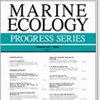东太平洋海星超数臂的生态后果
IF 2.2
3区 环境科学与生态学
Q2 ECOLOGY
引用次数: 0
摘要
摘要:五臂对称是棘皮动物的特征,在海星中最容易观察到。然而,一些五体海星个体偏离了正常的五臂模式,这很可能是由于再生过程中的错误造成的,但人们对这些偏离的频率及其对个体造成的生态后果知之甚少。在这里,我们报告了在多个共生海星物种种群中偏离五臂模式的程度,并测试了其中一个物种--蝙蝠海星(Patiria miniata)--多臂的三个潜在优势--增加的口腔表面积、增加的摄食量和更快的右旋反应。通过在加拿大不列颠哥伦比亚省巴克利湾的 16 个地点进行水下调查和行为实验,我们在 9 个五棘海星物种中的 5 个物种中发现了具有非典型臂数的个体。不同地点和物种之间存在明显差异,特定地点的非典型海星平均百分比从0.8%到14.6%不等,特定物种的平均百分比从0%到10%不等。蝙蝠星具有非典型臂数的个体比例最高,具体地点的频率从0到25%不等。有和没有编数臂的蝠星的进食概率和扶正速度相似,但在臂长一定的情况下,有编数臂的蝠星的口腔表面积稍大,这可能使其在粘附基质方面具有优势。虽然蝠星的编外臂的优势似乎可以忽略不计,但缺乏任何明显的劣势表明,对非典型变体的选择可能很弱,从而导致对该物种再生准确性的选择有限。本文章由计算机程序翻译,如有差异,请以英文原文为准。
Ecological consequences of supernumerary arms in eastern Pacific sea stars
ABSTRACT: Pentameric symmetry characterizes echinoderms and is most readily observed in sea stars. However, some pentamerous sea star individuals deviate from the normal 5-arm pattern, most likely as a result of errors in regeneration, but the frequency of these deviations and their ecological consequences for the individuals are poorly understood. Here, we report the extent of deviations from pentamery in multiple populations of co-occurring sea star species and tested 3 potential advantages of supernumerary arms—increased oral surface area, increased feeding, and faster righting response—in 1 species, the bat star Patiria miniata. Using underwater surveys and behavioural experiments at 16 sites in Barkley Sound, British Columbia, Canada, we found individuals with atypical arm numbers in 5 of 9 pentamerous sea star species. There were significant differences among sites and species, with site-specific mean percentages of atypical sea stars ranging from 0.8 to 14.6% and species-specific mean percentages ranging from 0 to 10%. Bat stars had the highest proportion of individuals with atypical numbers of arms, with site-specific frequencies ranging from 0 to 25%. The probability of feeding and righting speed were similar between bat stars with and without supernumerary arms, but bat stars with supernumerary arms had slightly larger oral surface areas for a given arm length, which could confer an advantage in adherence to the substrate. Although the advantages of supernumerary arms for bat stars appear to be negligible, the lack of any clear disadvantage suggests that selection against atypical variants might be weak, leading to limited selection on the accuracy of regeneration in this species.
求助全文
通过发布文献求助,成功后即可免费获取论文全文。
去求助
来源期刊

Marine Ecology Progress Series
环境科学-海洋学
CiteScore
5.30
自引率
8.00%
发文量
238
审稿时长
3 months
期刊介绍:
The leading journal in its field, MEPS covers all aspects of marine ecology, fundamental and applied. Topics covered include microbiology, botany, zoology, ecosystem research, biological oceanography, ecological aspects of fisheries and aquaculture, pollution, environmental protection, conservation, and resource management.
 求助内容:
求助内容: 应助结果提醒方式:
应助结果提醒方式:


